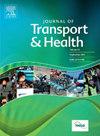Planning for driving cessation: a cross-sectional study of community dwelling older drivers (NZPATHS)
IF 3.3
3区 工程技术
Q2 PUBLIC, ENVIRONMENTAL & OCCUPATIONAL HEALTH
引用次数: 0
Abstract
Introduction
This study investigated the extent of driving cessation planning among older drivers, characteristics associated with planning, and types of plans made.
Method
Cross-sectional analysis of baseline data from New Zealand Prospective Older Adult Transport and Health Study (NZPATHS); population-based study of 1181 community-dwelling drivers (65–97 years).
Results
Fifty-five percent of participants had considered the possibility of driving cessation; 10 % had made at least one plan (active planners), such as exploring alternative transport options. Having made active plans for driving cessation was independently associated with older age, identifying as female, and ethnicity. After adjusting for these factors, those who reported poorer health, anticipated driving problems within five years or had discussed their driving with family or friends were more likely to be active planners. They were more likely to walk or use alternate modes compared with non-planners. Conversely, drivers who considered continuing to drive to be very important, drove more kilometres, or had access to rides with others were less likely to be planners.
Conclusions
Driving cessation planning is shaped by personal perceptions and contextual factors, with older adults who perceive potential challenges to their driving or health more likely to actively prepare. Older adults who see driving as essential or have access to transport through social networks may delay or avoid planning, potentially a problem if cessation is abrupt. The importance of planning in adaptation to driving cessation and transport dependence remains unclear and longitudinal research with waves 1–4 (2016–2023) of the NZPATHS cohort is underway to examine this.
戒烟计划:社区居住老年司机的横断面研究(NZPATHS)
本研究调查了老年司机戒烟计划的程度,与计划相关的特征,以及制定计划的类型。方法对新西兰前瞻性老年人交通与健康研究(NZPATHS)基线数据进行横断面分析;基于人群的1181名社区居住司机(65-97岁)研究。结果55%的参与者考虑过戒烟的可能性;10%的人至少制定了一项计划(积极规划者),例如探索其他交通选择。制定积极的戒烟计划与年龄、性别和种族独立相关。在对这些因素进行调整后,那些报告健康状况较差、预计在五年内会出现驾驶问题或与家人或朋友讨论过驾驶情况的人更有可能成为积极的规划者。与不做计划的人相比,他们更有可能步行或使用其他交通方式。相反,那些认为继续开车是非常重要的,开了更多的公里,或者有机会和别人搭车的司机不太可能成为计划者。结论:戒烟计划受到个人认知和环境因素的影响,老年人认为他们的驾驶或健康可能面临挑战,他们更有可能积极准备。老年人认为开车是必不可少的,或者通过社交网络可以获得交通工具,他们可能会推迟或避免计划,如果突然停止,这可能会成为一个问题。规划在适应驾驶停止和交通依赖方面的重要性尚不清楚,NZPATHS队列的1-4期(2016-2023)纵向研究正在进行中,以检验这一点。
本文章由计算机程序翻译,如有差异,请以英文原文为准。
求助全文
约1分钟内获得全文
求助全文

 求助内容:
求助内容: 应助结果提醒方式:
应助结果提醒方式:


